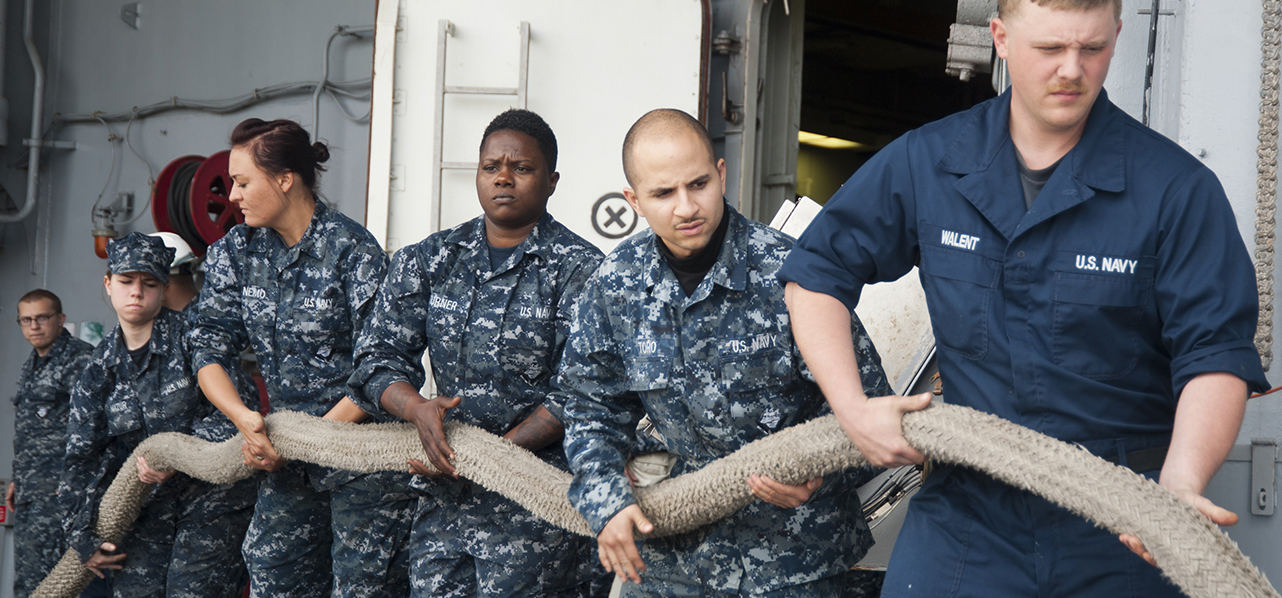The Camo Chronicles, Part 6: Blueberry Jam
Anyone who’s studied the controversies surrounding the U.S. military’s quest for camouflage has to come to the conclusion that, no matter how seemingly perfect a new design might be, it’s impossible to please all the people all the time. In the case of the Navy’s rollout and deployment of its new Navy Working Uniforms, though, it turns out that one of critics of the new designs just happened to be someone whose opinion is worth more than just thoughtful consideration.
“The Navy ‘blueberries’—I don't know what the name is, that's what sailors call them—the great camouflage it gives is if you fall overboard.” This blunt assessment of the new unis came from none other than Ray Mabus, the United States Secretary of the Navy, in 2013. But the “blueberries,” the nickname for the Navy Working Uniform (NWU) Type I, also had supporters, including enlisted personnel who appreciated its ease of maintenance and distinct look.
The Navy started the overhaul of its working uniforms in 2003 with a service-wide survey to find out not only what qualities sailors deemed important in a uniform, but also what style they preferred. Practicality was a major factor for the respondents: they wanted unis that were easy to clean, required no ironing, had a long wear life, and were comfortable and practical in a variety of workplace environments and climates. And a majority said they preferred a BDU (Battle Dress Uniform) camo-based uniform, as opposed to the workaday look dungarees-and-chambray, utilities, or coveralls.
In October 2004, the Navy released a set of concept working uniforms featuring a digital camo pattern of blues, grays, and black—a color scheme chosen primarily because it made the grease and paint stains that stood out on previous work uniforms much harder to notice. The pattern also made something else tough to spot: sailors who fall overboard. Enlisted personnel can get pretty creative with nicknames, and it wasn’t long after the Navy began issuing the NWU Type I in 2009 that sailors had coined the term “aquaflage.”

Sailors wearing the Navy Working Uniform Type I. An impromptu burn test revealed its NYCO blend was highly susceptible to catching on fire and melting.
The NWU Type I came under fire—quite literally—in late 2012 when someone at the Navy Clothing and Textile Research Facility (NCTRF) conducted an impromptu test of the NWU Type I’s flame resistance and found that its nylon-cotton (NYCO) material “burned robustly.” This shouldn’t have come as a surprise to the researchers: the flammability of NYCO is well-known, and the Navy had removed the requirement that working uniforms be flame-retardant 16 years earlier. But the results were still troubling in light of the fact that one of the Navy’s mantras is that “every sailor is a firefighter.”
To its credit, the Navy didn’t drag its feet in addressing this critical issue. Within ten months, flame-resistant variants of coveralls were being issued to all sailors, along with orders that the blueberries could no longer be worn while underway. Last year, the Chief Naval Officer suggested that the coveralls might wind up replacing the NWU Type 1—a possibility that seems much more likely with the September 2015 announcement that the seabag requirement for NWU Type 1 unis was being decreased from four to three.
Thankfully, the Navy ran into far fewer issues in developing two other uniforms for personnel deployed on the ground, NWU Type II (digital desert) and Type III (digital woodland). Dubbed AOR (“Area of Responsibility”) 1 and 2 during a highly secretive testing period, the final patterns are highly similar to the Marine Corps’ MARPAT—no shocker, since the MARPAT patent rights are assigned to the “United States of America as represented by the Secretary of the Navy.” The only snag was which Navy personnel would wear which camo. Approval of both types came at the end of 2009, but it took more than 18 months for the final verdict to come down: NWU Type II would only be worn by Naval Special Warfare (NSW) personnel, sailors assigned to NSW units, or sailors assigned to units directly supporting NSW missions. NWU Type II, on the other hand, was designated the standard camouflage uniform to be worn by all other deployed sailors, which means some sailors deployed in desert terrain will be wearing woodland camouflage. The delineation was the result of the Marine Corps’ concerns that the strong resemblance between NWU Type II and MARPAT might cause confusion in forward deployments.
It’s not the most elegant solution, but this bifurcated system certainly isn’t written in stone. And having to decide which units will wear one of two effective camo patterns ranks pretty low on the frustration scale compared to other issues that have cropped up in the great camo quest.